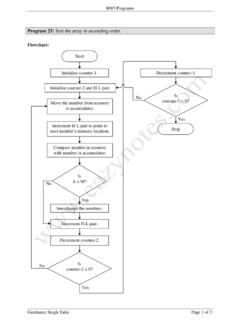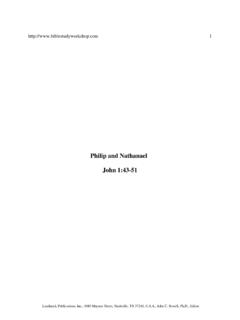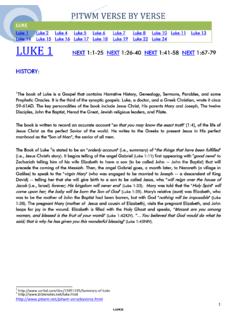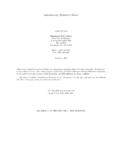Transcription of Chord Progressions - Darks' Grateful Dead Tabs - …
1 Chord Progressions @ Chord Progressions @ 2. Chord Progressions @ All Rights Reserved 2000 - 2009 by Richard Scott No part of this book may be reproduced or transmitted in any form or by any means, graphic, electronic, or mechanical, including photocopying, recording, taping, or by any information storage retrieval system without the written permission of the publisher. For information contact: Richard Scott at: Printed in the United States 3. Contents Introduction .. 6. ascending Augmented Progressions .. 7. ascending Bass 9. Backdoor progression .. 11. Basic Progressions .. 12. Basie Blues Changes .. 13. Blues Progressions .. 14. Blues With A Bridge .. 23. Bridge 24. Cadences .. 25. 26. Circle Progressions .. 29. Classic Rock 30. Coltrane Changes .. 31. Combination Progressions .. 34. Constant Structure progression .. 35. Counterpoint .. 36. Descending Bass Lines .. 38. Descending Minor Cliche.
2 40. Diatonic Circle 42. Diminished Cliche Progressions .. 44. Double tonic .. 46. Doo-Wop Progressions .. 48. 8-Bar Blues 51. Endings .. 53. Flamenco Progressions .. 54. Folk Progressions .. 56. General Chord progression 58. Gospel progression .. 61. 62. Jazz 63. 4. La Folia .. 64. Minor Plagal Cadences .. 68. Modulation .. 69. Omnibus progression .. 73. One- Chord Progressions .. 75. Parker Blues Changes .. 76. Passamezzo Moderno progression .. 78. Pedal 81. Pop-Rock Lydian II Progressions .. 83. Ragtime 85. Relative Minor Vamps .. 89. Rhythm Changes .. 92. Rock and Roll Progressions .. 97. Rock Ballad Progressions .. 99. 16-Bar Blues 101. Standard Progressions .. 103. Stomp progression .. 105. Tritone Progressions .. 108. Turnarounds .. 109. 24-Bar Blues 112. Vamps .. 113. Vanilla Changes .. 115. About .. 116. 5. Introduction "The recipe for music is part melody, lyric, rhythm, and harmony ( Chord Progressions ).
3 The term Chord progression refers to a succession of tones or chords played in a particular order for a specified duration that harmonizes with the melody. Except for styles such as rap and free jazz, Chord Progressions are an essential building block of contemporary western music establishing the basic framework of a song. If you take a look at a large number of popular songs, you will find that certain combinations of chords are used repeatedly because the individual chords just simply sound good together. I call these popular Chord Progressions the money chords. These money Chord patterns vary in length from one- or two- Chord Progressions to sequences lasting for the whole song such as the twelve-bar blues and thirty-two bar rhythm changes." (Excerpt from Chord Progressions For Songwriters 2003 by Richard J. Scott) Every guitarist should have a working knowledge of how these Chord Progressions are created and used in popular music.
4 Click below for the best in free Chord Progressions lessons available on the web. 6. ascending Augmented Progressions (I-I+-I6-I7). "Inserting the "C+" (common tone substitution), the "C6" (embellishment), and the "C7" ( Chord quality change) in the "C" one- Chord progression creates the "C-C+-C6-C7" ascending augmented propression a shown below. One- Chord progression : |C / C / |C / C / |. ascending Augmented: |C / C+ / |C6 / C7 / |. An example of this type of pedal point is the opening verse progression to Whitney Houston's 1986 hit The Greatest Love Of All. The box below shows other examples of this type of pedal point. Notice that the "C-C+-C6-C+" pedal point has a middle voice line that moves both up and down. The "C-C+-C6" and "C-C+" examples are further variations (omitted chords) of this type of pedal point." (Excerpt from Chord Progressions For Songwriters 2003 by Richard J. Scott).
5 (You've Got To) Accentuate The Positive chorus (Standard - 1944), Because verse (Dave Clark Five - 1964), Laughing verse (Guess Who - 1969), Love Will C C+ C6 C7. Keep Us Together chorus (Captain & Tennille - 1975), and Stand Tall verse (Burton Cummings - 1976). Maybe This Time verse (from "Cabaret" - 1966) and Losing My Mind verse C C+ C6 C9. (from "Follies" - 1971). Louise A section (from "Innocents Of Paris" - 1929), Match Maker A section C C+ C6 C+. (Standard - 1964), and (Just Like) Starting Over verse (John Lennon - 1980). C C+ C6 C#o7 For Once In My Life verse (Stevie Wonder - 1968). C C+ - - Baby Hold On To Me verse (Eddie Money - 1978). Guitarists should be able to easily play typical ascending augmented progression Chord changes in the most commonly used keys. Below are the Chord fingerings I like for various ascending augmented Progressions . Laughing verse: A = x07655 A+ = x07665 A6 = x07675 A7 = x07685.
6 Dmaj7 = xx0675 Dm7 = xx0565 C#m7 = x46454 E = 022100. The Greatest Love Of All verse: E = 022100 E+ = 03211x E6 + = 02x12x E7 = 02x13x A = x0222x A+ = x0322x A6 = x0422x A+ = x0322x 7. Stand Tall verse: G = 3x0003 G+ = 3x1003 G6 = 3x2003 G7 = 3x3003. Cmaj7 = x32000 Cm = x35543 G= 320003 C= 032010. Maybe This Time verse: C = x32010 C+ = x3211x C6 = x3221x C9 = x32330. F = xx3211 F+ = xx3221 Dm = xx0231 F#o7 = xx1212. As with learning any new progression , you should study it by playing it in all twelve keys. Also, try substituting the ascending augmented progression where a I Chord is used for two or more bars. 8. ascending Bass Lines ascending bass line Progressions are a type of moving bass line progression where the bass notes of each Chord in the progression move higher typically following the "1-2-3-4," "2-3-4-5," "1-2-4-5", or "1-3-4- 5," "1-#1-2-#2," "1-#1-2-5," and "1-2-b3-3" note bass lines.
7 ascending bass line Progressions are popular with songwriters wishing to create a bright sound. Scott Joplin and other Ragtime writers frequently used the "IV-#IVo-V7" progression to brighten their songs. Some great popular music of the last century has been written around ascending bass line Progressions such as Ain't She Sweet (1927), Ain't Misbehavin'. (1929), Stormy Weather (1933), Oh What A Beautiful Morning (1943), I'm Gonna Wash That Man Right Outa My Hair (1949), Like A Rolling Stone (1965), As Tears Go By (1966), I'm Not Your Steppin' Stone (1967), Love Is All Around (1968), Bend Me Shape Me (1968), Lean On Me (1972), Live And Let Die (1973), Slow Dancin' (1977), With A Little Luck (1978), My Life (1979), Key Largo (1982), Have I Told You Lately (1989), and Heart Of The Matter (1990). Three great examples of ascending bass lines are shown below in the key of C. Ain't Misbehavin' (Fats Waller - 1929) opening A section progression [1-#1-2-#2 chromatic pattern].
8 C / C#o7 / Dm7 / D#o7 / C/E / E7#5 / F6 / Fm6 /. Like A Rolling Stone (Bob Dylan - 1965) opening verse progression [1-2-3-4-5 diatonic pattern]. C / Dm / Em / F / G/// ////. Somewhere Out There (Linda Ronstadt & James Ingram - 1987) opening verse progression [1-3-4-5 diatonic pattern]. Cadd9 / Cmaj7/E / Fmaj7 / G11 /. Hear a midi of the I-ii-iii-IV diatonic Chord stream by clicking here. The Beatles used this progression to create the verse for their Here, There, and Everywhere. Click below for the best in free ascending Bass Lines lessons available on the web as well as links to various song examples. Lessons ascending Augmented I-I+-I6-I7 Progressions (MoneyChords). Chord Stream - I-ii-iii progression (Olav Torvund). Chord Stream - I-ii-iii-IV progression (Olav Torvund). The "Creep" Chord progression (PSR Tutorial). Diminished Cliche I-#Io-IV-V Progressions (MoneyChords). Rock Ballad I-iii-IV-V Progressions (MoneyChords).
9 9. Song Examples Ain't Misbehavin' (MoneyChords). Don't Get Around Much Anymore (MoneyChords). Hotel California (MoneyChords). Like A Rolling Stone (MoneyChords). 10. Backdoor progression (From Wikipedia). In jazz and jazz harmony, the Chord progression from iv7 to I, or flat-VII7 ( VII) to I has been nicknamed the backdoor progression or the backdoor ii-V. This name derives from an assumption that the normal progression to the tonic (V7 to I, or the authentic cadence) is, by inference, the front door. Backdoor ii-V refers to VII serving as a substitute for V in the ii-V-I. turnaround. The backdoor ii-V is considered a "bluesy" cadence and IV- VII-I is used repeatedly as a Chord substitution, along with tritone substitution, in "Lazy Bird", John Coltrane's arrangement of Tadd Dameron's "Lady Bird". The backdoor progression can be found in popular jazz standards in such places as measures 9.
10 And 11 of "My Romance" or measures 10 and 28 of "There Will Never Be Another You", as well as Beatles songs like "In My Life" and "If I Fell". It can be considered a minor plagal cadence in traditional theory. The flat-VII7 Chord , a pivot Chord borrowed from the parallel minor of the current key, is a dominant seventh. Therefore it can resolve to I; it is commonly preceded by IV going to iv, then flat-VII7, then I. 11. Basic Progressions (I-IV). "The repeated E-A Basic progression , which follows the Circle Of Fifths movement, is one of the least complex and most popular changes in all popular music with numerous examples found throughout the twentieth century. Keith Richards of the Rolling Stones has made millions of dollars over the years writing and playing hard rock songs with these two basic chords played on an open G tuned electric guitar. Examples of hit songs created around the Basic progression include the Beatles 1964 Love Me Do, John Denver s 1974 number one Sunshine On My Shoulders, and Bruce Springsteen s 1985 Glory Days.











